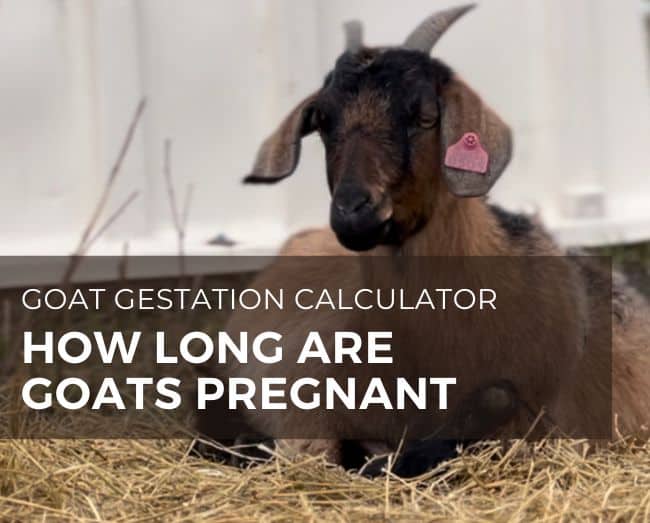Understanding the goat gestation period is important for successful and healthy pregnancies. This article will cover how long goats are pregnant, the stages of gestation, care, and record keeping.
Bonus, there’s also an easy goat gestation calculator included! Jump to the calculator
What is the goat gestation period?
The goat gestation period is a segment of time from conception to birth, also known as pregnancy.
How long is the pregnancy of a goat?
The typical length of pregnancy of a goat, or gestation period, is 145 to 150 days from the date the female goat was exposed to (or bred by) the buck.
Goat gestation also calculates out to roughly 5 months of pregnancy or 21 weeks of pregnancy.
Factors impacting the gestational period
There are a number of factors that may impact the actual delivery date of your goat:
- Breed size. Smaller goat breeds tend to have slightly shorter gestation, roughly five days shorter.
- Estrus cycle. Does have an estrus cycle of 21 days. Even if a buck is put in with your goats, it’s possible the pregnancy due dates may be delayed pending at what point your does are cycling and when they come into heat.
- First-time mother goat. Sometimes a first-time pregnant goat may be bred later or in a second heat cycle, resulting in what seems to be longer gestation times.
- Proper nutrition. Making sure the pregnant doe has the proper nutrition through the entire pregnancy, especially the last month is important (more information is the stages of goat pregnancy section)
Goat Gestation Calculator
Use this goat gestation calculator to easily calculate the due date of your pregnant goats. If you have a smaller goat breed, your doe may be due up to five days earlier.
Note this goat gestation calculator serves as an estimate for your goat’s due date.
Stages of goat pregnancy
Goat pregnancy or the gestational period is split into trimesters. The chart below will outline the trimesters by timeframe, as well as the doe’s diet, health, and proper care.
| Trimester | Time Frame | Nutritional Needs | Management |
|---|---|---|---|
| First Trimester | 1-50 days | Slightly above maintenance; diet stability is especially important after conception | |
| Second Trimester | 51-100 days | Same as first trimester | |
| Third Trimester | 101-150 days | At 3-4 weeks before kidding, or one month before the due dates, increase the quality of the feed to prevent pregnancy toxemia and encourage normal kid development. Avoid over feeding, which can also lead to pregnancy toxemia. | At 3-4 weeks/1 month before the due date: – trim hooves, if needed – give CDT, if administering – give BoSe, if advised by a vet for selenium and vitamin E deficiencies |
Other tips for throughout the stages of pregnancy
- Keep pregnant does with other goats they’ve been grouped with to avoid any unneeded stress throughout the pregnancy. This will help reduce the potential for abortion.
- Observe does daily for any health concerns
Pregnancy record keeping
Keep detailed records for each goat’s pregnancy, including the date exposed and actual birth date to calculate the gestation length, as well as additional records about the health during the pregnancy. This way you’ll have a better idea of when and how to monitor future pregnancies with each goat.
Preparing for goat kidding
To get prepared for goat kidding, you can learn more with my articles on kidding pens and newborn goat care.
References:
- Nutrient requirements of small ruminants (2007). National Research Council for the National Academies.

LEAVE A COMMENT
Comments